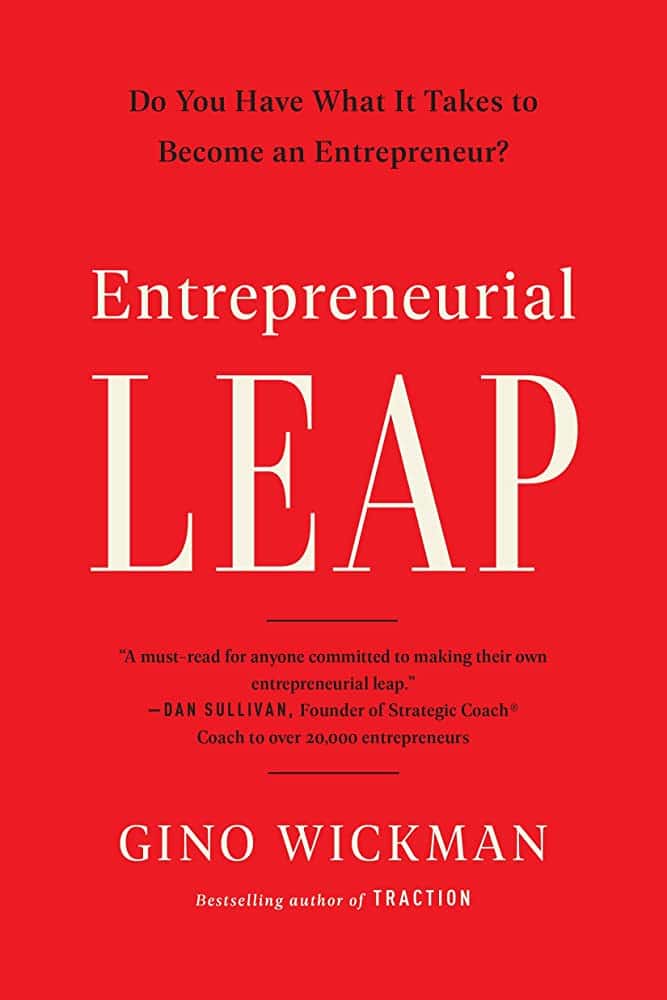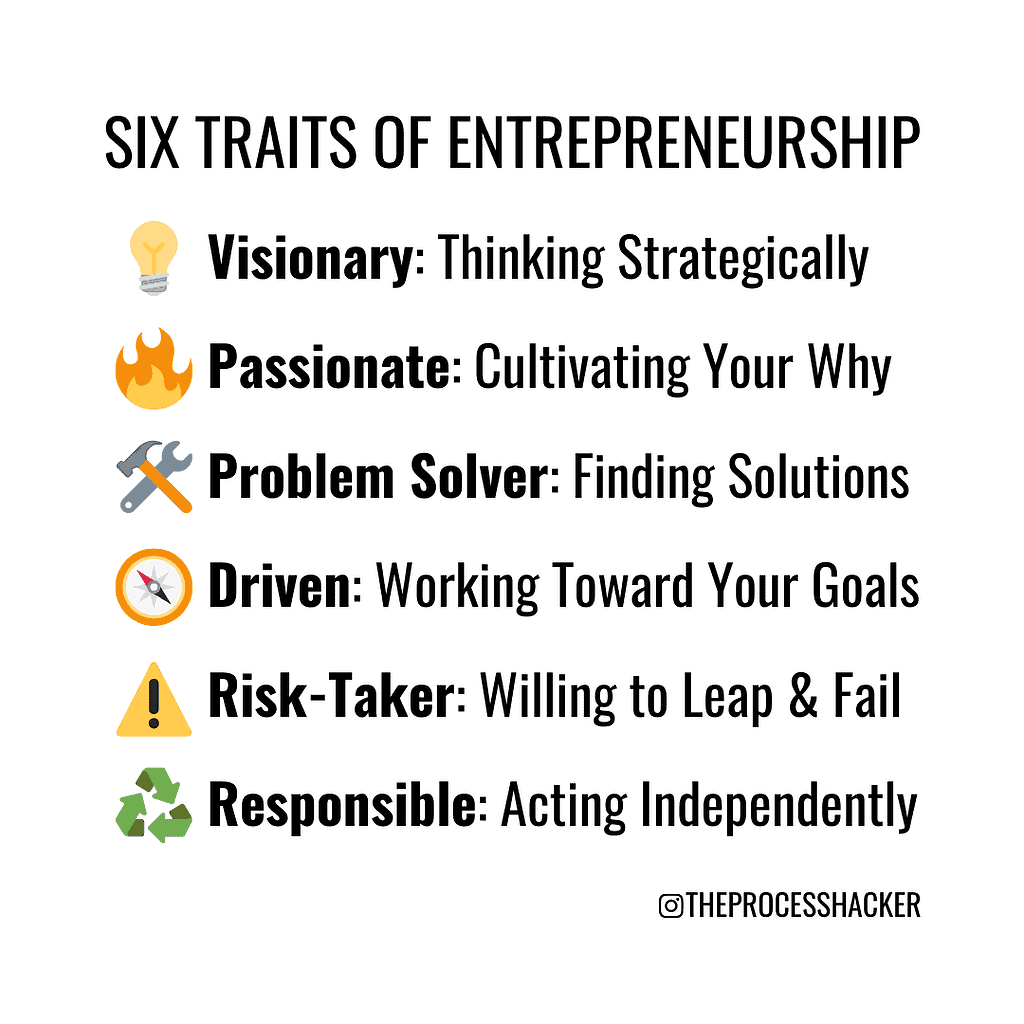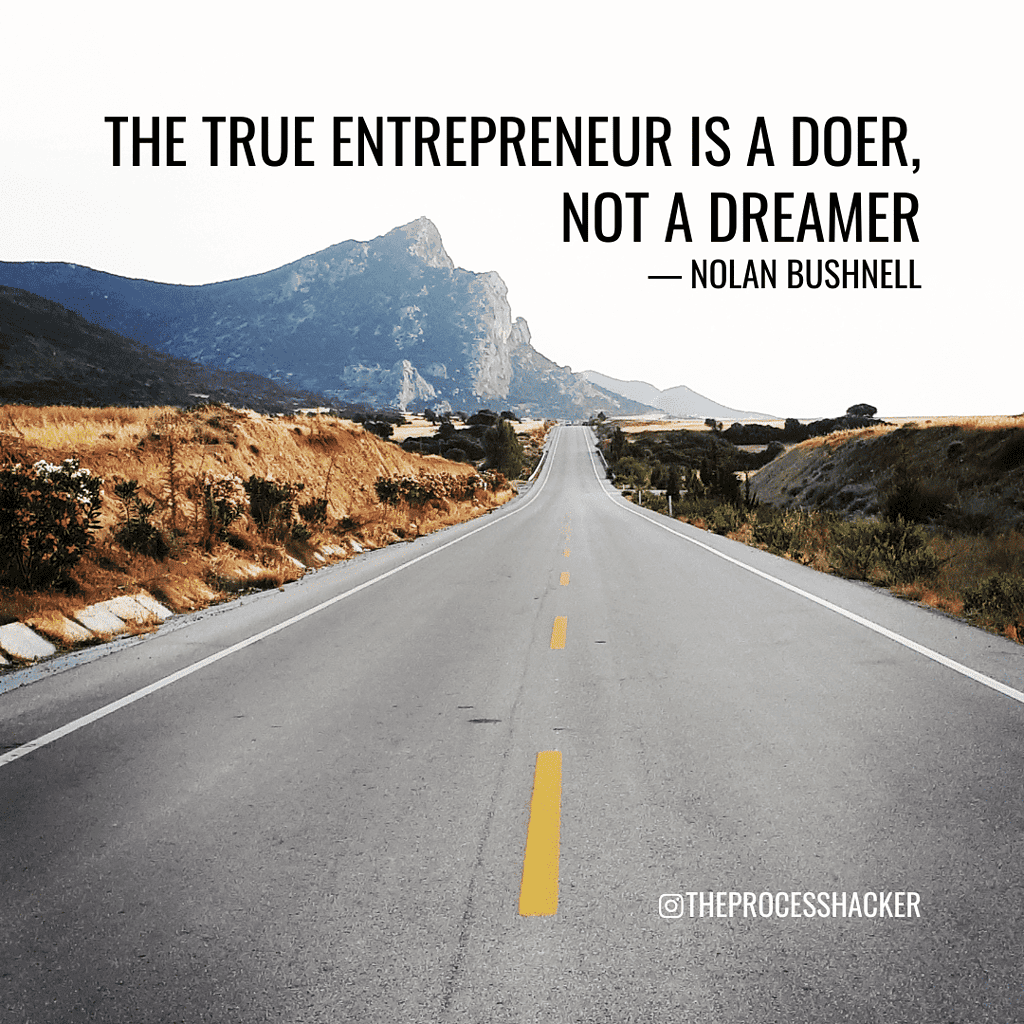Entrepreneurial Leap by Gino Wickman | Summary
Taking the entrepreneurial leap is nerve-racking, strenuous, challenging, inspiring, and rewarding. These entrepreneurs create many jobs, power the economy, build wealth, and change the world. The book, Entrepreneurial Leap by Gino Wickman will help you determine if you are an Entrepreneur-in-the-making or not.
Gino Wickman cofounded and sold EOS Worldwide, which is the company that helps businesses grow with its Entrepreneurial Operating System (EOS). EOS is a complete toolbox that helps entrepreneurs establish their vision, take action, and improve their business. To learn more about EOS, check out our summary of Traction: Get a Grip on Your Business.
Buy Entrepreneurial Leap on Amazon

Entrepreneurial Leap by Gino Wickman
Do You Have What it Takes to Become an Entrepreneur?
Download the PDF Book Summary for Entrepreneurial Leap
Introduction
Gino Wichman provides several definitions to start with:
Entrepreneur – “someone who sees a need or an opportunity and takes the risk to start a business to fulfill or remedy that need or opportunity by creating something or improving upon an existing product or service”
Entrepreneur-in-the-making – “individual with a unique set of traits possessed by all true entrepreneurs but who has not yet taken an entrepreneurial leap”
This book will help you determine if you are an Entrepreneur-in-the-making, take the Entrepreneurial Leap, and become an entrepreneur.
Part 1 – Confirm You are an Entrepreneur-in-the-making
The first part of Entrepreneurial Leap will help you determine if you are an Entrepreneur-in-the-making or not.
Chapter 1 – Know Thyself
This chapter describes the entrepreneurial spirit:
- Generates ideas and pursues dreams
- Thinks strategically and about the big picture
- Is persuasive, passionate, and obsessive
- Works hard, is driven, and ambitious
- Is motivated financially and has a business mindset
The author states that if 80 percent of what is covered in the chapter resonates with you, you may be an Entrepreneur-in-the-making, take the Entrepreneurial Leap, and become an entrepreneur.
Chapter 2 – Essential Traits of an Entrepreneur
The following six traits, or “genetically-determined characteristics,” are essential to being an entrepreneur:
- Visionary – “being imaginative, creative, inventive, ingenious, enterprising, and innovative”
- Passionate – “showing or caused by strong feelings or a strong belief”
- Problem Solver – “someone who leans into problems, obsesses about them, and genuinely gets a high from solving them”
- Driven – “relentlessly compelled by the need to accomplish a goal; very hard-working and ambitious”
- Risk-taker – “someone willing to take a leap and willing to fail”
- Responsible – “ability to act independently and make decisions without authorization”
If you can’t answer yes to having all six traits, you should not be an entrepreneur.
Chapter 3 – Missing an Essential Trait?
In his book, The E-Myth Revisited (book summary), Michael Gerber says that most businesses are started by technicians resulting in failure. Technicians are great at their specific job but lack the six essential traits. So, what happens if you are missing one of the six essential traits?
- Not Being Visionary: You will struggle to see the bigger picture, produce something, and continuously innovate.
- Not Being Passionate: You will be unable to endure the many challenges that occur along the way.
- Not Being a Problem Solver: You will not have the ability or desire to turn your idea into a product or service.
- Not Being Driven: As many entrepreneurs fail, you will struggle to have the desire to succeed.
- Not Taking Risks: You are afraid to take the entrepreneurial leap and make difficult decisions.
- Not Being Responsible: You are unwilling to take responsibility, blame others, and feel entitled.
If you don’t have one of the six essential traits, you may be closer to being self-employed than a true entrepreneur.
Chapter 4 – Second-Generation Entrepreneurs
This chapter provides the following advice for younger generations thinking about working in or taking over their family’s business:
- Parents should understand that their role could be taken by anyone, including their son or daughter.
- Parents should provide positions that are suitable for the younger generation’s skills.
- Younger generations should try to succeed in a different work setting before working in the family business.
- Younger generations should be willing to work harder than others to earn the same level of respect.
Note that less than 15 percent of multi-generational-family businesses survive to a third generation.
Chapter 5 – Entreprenuer-in-the-making Assessment
This chapter is the final filter to determine whether you should be an entrepreneur or not. You can get the 25-question assessment from the book or download it from the Entrepreneurial Leap website. A score of 90 percent or higher means you are probably an Entrepreneur-in-the-making. Lower scores may indicate that you may be more likely to be self-employed.
Download the PDF Book Summary for Entrepreneurial Leap
Part 2 – Glimpse of the Entrepreneurial Life
The second part of the book illustrates the life of an entrepreneur to inspire you to take the Entrepreneurial Leap.
Chapter 6 – Businesses, Industries, and Sizes
This chapter illustrates the three main factors that will help you, as an Entrepreneur-in-the-making, determine what business to start:
- Industry: Categorizes companies by the specific kind of good or service produced, like hospitality, information technology, real estate, etc.
- Type of Business: Differentiates the business by (1) delivering a service or product; (2) deciding between Business-to-business (B2B) or Business-to-consumer (B2C); and (3) pricing at the high-end or low-end.
- Size of Business: Separates companies by the top-line annual revenue, profitability, and the number of employees.
You should use the MyBiz Match tool on the Entrepreneurial Leap website to help you determine the factors for you.
Chapter 7 – Real-Life Entrepreneurial Stories
There’s no universal way to do business. There are many remarkable stories of entrepreneurs succeeding in business, including the following:
- Steve Jobs and Steve Wozniak cofounded Apple to sell the Apple I Computer.
- Henry Ford mass-produced the automobile at the Ford Motor Company.
- Walt Disney and his brother, Roy, cofounded the Walt Disney Company to create short cartoon films.
The author also provides eight stories of lesser-known successful entrepreneurs. You may not have heard of them, but they are successful, wealthy, and happy.
Chapter 8 – Living the Dream: A Day in the Life
This chapter illustrates the entrepreneur’s best-case scenario: this dream is what your life could be like in 10 years:
- Have a great offering and passionate customers.
- Have a team of people that report directly to you.
- Meet with customers to understand needs, solve problems, and ensure value.
- Solve problems, make critical decisions, and juggle several projects.
- Are compensated well through pay and profit distribution.
This dream scenario is entirely possible.
Chapter 9 – Living the Nightmare: A Day in Hell
This chapter illustrates the entrepreneur’s worst-case scenario: this is the nightmare at the opposite end of the spectrum.
Eight entrepreneurial mistakes result in the nightmare scenario:
- Not Having a Vision: Vision is essential to outline who you are and where you are going as an organization. Define your vision using the MyVision Clarifier tool.
- Hiring the Wrong People: The right people will support company growth and embody your core values.
- Not Spending Time with Your People: Stay in touch to get feedback, give feedback, and have everyone on the same page.
- Not Knowing Who Your Customer Is: Understand your ideal customer or his or her best client, so your marketing is effective. Build your storybrand!
- Not Charging Enough: Raise your prices for your products and services, so they scare you.
- Not Staying True to Your Core: Center in on your Core Focus, which is the purpose of why your company exists.
- Not Knowing Your Numbers: Data supports you in communicating and making decisions effectively.
- Not Clarifying Roles and Responsibilities: Have an accountability structure with clear expectations.
This nightmare scenario is entirely avoidable, so understand these 8 mistakes.
Download the PDF Book Summary for Entrepreneurial Leap
Part 3 – Path of an Entrepreneur
The third part of Entrepreneurial Leap walkthroughs the journey of the entrepreneur and identifies common mistakes along the way.
Chapter 10 – College or Not?
Most successful entrepreneurs say that they don’t use what they learned in college. Gino Wickman didn’t go to college, but he asked questions to others on their experience and found that:
- Going to college resulted in having valuable social, networking, and relationship experiences.
- Most would go to college again but would take classes that would help them become a better entrepreneur.
Thus, it may make sense for an Entrepreneur-in-the-making to go to college. However, if you don’t go to college, you must still educate yourself in your way and interests. Decide on the right way to educate yourself based on your needs, and when in doubt, you probably should go to college.
Chapter 11 – Discover Your Passion
This chapter will help you discover and work on your passion, which is also known as “your purpose, cause, calling, your why, your obsession, or mission.” Then, create a business around your passion to be successful.
Gino Wickman categorizes passions into four groups:
- Serving the customer
- Scaling an awesome organization
- Solving issues and innovating
- Winning by being the best or biggest
Also, Dr. Gary Sanchez’s “9 Whys” has another tool to help you find your passion. He believes that “your passion comes from knowing your Why, How, and What. He says when What you do is in line with Why you do it and How you want to express it, you’ll have passion for what you do. And passion is the fuel that gives you the energy to pursue your dreams.”
Follow these steps to find your passion:
- List your top three successes.
- List your top three failures.
- Ask yourself what has life prepared for you?
Chapter 12 – Find a Mentor
Having a mentor and receiving mentorship is crucial to be a successful entrepreneur:
Mentor – “an experienced and trusted advisor, counselor, or guide”
Mentorship – “finding someone who is where you want to be and asking that person to take you under their wing and teach you everything they know”
Follow these steps to find a mentor:
- Think about what you want to create and who you want to be as an entrepreneur.
- Consider various candidates, and they may not be in a similar business.
- Reach out and meet with your candidates and share your stories and passions.
- When you find a good fit, agree on a format and expectations for the relationship.
After finding your mentor, cultivate the relationship by:
- Showing them that you are applying their teachings in your life and business.
- Expressing gratitude frequently for their time, commitment, and expertise.
You will evolve through mentors for different stages of your life and entrepreneurial journey.
Chapter 13 – Take Action and Be Patient
As an Entrepreneur-in-the-making, you need to both:
- Take Action: “Put the pedal to the metal.”
- Be Patient: “Need to slam on the brakes.”
These complementary actions will help you manage expectations and avoid frustration.
Think in longer (about ten-year) time frames as Bill Gates has said that “Most people overestimate what they can do in one year and underestimate what they can do in ten years.” Try things to move forward in your life and business: learn, create, work, and experiment.
Chapter 14 – Taking the Entrepreneurial Leap: Starting Your Business
There are eight disciplines to improve being successful:
- Clarify Your Vision: Document your Vision to include your passion, ideal customer, offerings, goals, etc. Define your vision using the MyVision Clarifier tool.
- Decide If You’re a “Partner Person:” Partnerships are challenging, may have issues, and are not for everyone.
- Solving Larger Problems Results in Greater Success: Provide value to your customer to earn a comparable profit.
- Get Feedback from Customers Early and Often: Give value and get feedback to improve your product or service.
- Always Have a Plan B: Be willing to adjust your plan and actions to favor something that works.
- Work Really Hard: Be disciplined and take consistent action.
- Take Criticism With a Grain of Salt: You will always have critics, so you need to keep moving forward.
- See It Every Night: Review your ten-year goal before bed to make it a reality.
There are many ways to start and grow your business, so just go for it and take the Entrepreneurial Leap!
Chapter 15 – Building Your Business: The Nine Stages
After selling a product or service, continue to build your business through the following nine stages:
- Generate Cash: The positive cash flow cycle is integral to having a business, so you must sell something and prove it has value.
- Hire an Integrator: They help execute your Vision, run the day-to-day operations, hold people accountable, and integrate resources.
- Discover Your Core Values: The Core Values are three to seven guiding principles that help you grow and have a strong culture.
- Hold Yourself Accountable: Decide on three important weekly metrics you must target to accomplish your yearly goals or quarterly goals.
- Communicate Often with Your People: Stay in touch frequently with your employees, so everyone works toward the Vision and you retain key employees.
- Have a Plan B, C, and D: You will need to follow your plan and adjust the direction when something changes or is not working.
- Stay in Your Personal Sweet Spot: When you reach your work capacity, hire specialists and a sales team, and delegate work to them.
- Prevent Your Business from Getting Away: Learn to say no, fire terrible clients, and refocus on your core product or generic service business.
- Capitalize on Coaching, Training, and Mentoring: The best entrepreneurs have mentors and coaches to advise them.
After going thought the nine stages, your business may be Built to Sell (summary). For additional knowledge on growing a business, check out Traction by Gino Wickman or read our book summary. This chapter also provides advice from 20 successful entrepreneurs.
Chapter 16 – An Entrepreneurial Lifetime of Growth, Learning, and Motivation
As a part of your entrepreneurial journey, you should continually educate yourself. Here are ten ways to learn:
- Read Nonfiction: Read at least one per month. Check out our book summaries to find your next read.
- Read Biographies: Learn stories from successful entrepreneurs.
- Listen to Podcasts: Hear interviews, talk shows, and educational segments.
- Watch Online Videos: Check out videos on leadership, motivation, entrepreneurship, and business.
- Read Business Blogs: Learn about business from websites like Entrepreneur.
- Connect with Entrepreneurs: Build relationships through networking, mentorship, coaching, and masterminds.
- Take a Personality Assessment: Learn about yourself using tools such as Kolbe A Index, DiSC, Myer-Briggs, etc.
- Take Time for Coffee: Spend at least an hour in a coffee shop to work “on” and review your business.
- Read Inspiration Quotes: Follow @theprocesshacker on Instagram for quote posts to motivate you.
- Look at Your Bank Balance: This metric will motivate you to keep working on your business.
To get more inspiration, check out our blog posts on 10 ways to learn and grow as an entrepreneur and 50 ways to learn something new.
Conclusion
“Becoming an entrepreneur is not something you do—it’s something you are.” Entrepreneurs have six critical traits: Vision, Passion, Problem Solving, Drive, Risk-Taking, and Responsibility.
Your journey will consist of four key steps:
- Dream up an idea, solution, product, or service that motivates you.
- Take the Entrepreneurial Leap to turn your vision into action and sell it to the world.
- Work really hard on your business for a long time.
- Evolve into a thriving, hardened entrepreneur.
In the end, Gino Wickman asks you, as an entrepreneur, to do three things:
- Save at least 15 percent of everything you earn.
- Live your ideal life by doing what you love, working with who you love, and making an impact.
- Commit yourself to a ten-year goal and write it down.
Download the PDF Book Summary for Entrepreneurial Leap
Next Steps
In Entrepreneurial Leap, Gino Wickman will help you determine if you are an Entrepreneur-in-the-making, take the Entrepreneurial Leap, and become an entrepreneur. I hope this blog post has inspired you to get your copy of Entrepreneurial Leap. For more from Gino Wickman, check out Traction: Get a Grip on Your Business (book summary) or check out the rest of the EOS library:
- Get a Grip: How to Get Everything You Want From Your Entrepreneurial Business (book summary and pdf free download): Tells a fictional business fable about an entrepreneurial company hitting the ceiling. In response, the company’s leadership implements EOS for success.
- Rocket Fuel (book summary): Provides a guide for the integral relationship between a Visionary and an Integrator.
- How to Be a Great Boss (book summary): Helps the leadership and management team at all levels of an organization get the most from their people.
- What the Heck is EOS? (book summary): Provide a complete and simplified guide on the EOS process and tools for your employees.
- The EOS Life: How to Live Your Ideal Entrepreneurial Life (pdf book summary): Live your ideal life “doing what you love, with people you love, making a huge difference, being compensated appropriately, with time for other passions.”
- Process (book summary): Helps you document, simply, and package your core processes such that they are followed by all in your organization.











